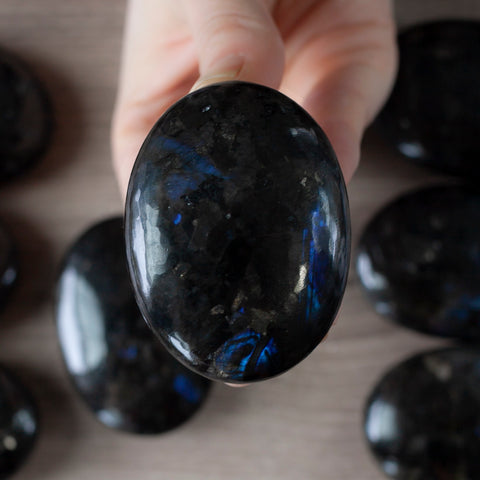
Larvikite may flash like Labradorite, but it's actually a unique type of Monzonite that comes primarily from Larvik, Norway. It is distinguished by its inclusions of plagioclase and alkali feldspar which create its characteristic blue and silver flash. Larvikite is usually rich in titanium and can also contain Olivine and Apatite. While Larvikite is relatively new to the general public, Larvikite has a long history and has been mined from the same location in Norway since 1884 and has historically been used for detail work in architecture. Larvikite has been recognized and designated by the International Union of Geological Sciences as a Global Heritage Stone Resource. Larvikite is the correct tradename for this stone, but it is also called Blue Moonstone or Blue Pearl Granite, neither of which are accurate.  Larvikite is an 'unmixed' stone on the micro-level. Alkali feldspar and plagioclase feldspar meet in alternating layers within Larvikite, causing the Schiller effect or Labradoresence - this appears as a slivery or blue flash of light from within the stone.
Larvikite is an 'unmixed' stone on the micro-level. Alkali feldspar and plagioclase feldspar meet in alternating layers within Larvikite, causing the Schiller effect or Labradoresence - this appears as a slivery or blue flash of light from within the stone.
Larvikite stones are nearly 300 million years old, occurring during the Precambrian period. Specifically, Larvikite is found in the Larvik Plutonic Complex which consists of 10 Plutons. Plutons are essentially cooled crystalized magma. Millions of years ago, large pools of magma were able to 'float' to the surface of the Earth's crust but did not erupt through a volcano. Because these pools remained underground, they were named after Pluto, the Roman God of the underworld. It is within these ancient stones, we find Larvikite today.
Larvikite Metaphysical Meaning and Use
Larvikite is an enchanting black stone that sparks a sense of wonder and curiosity. It inspires creative ideas and activates the imagination. Found within crystallized magma, Larvikite is deeply connected to the Earth’s ancient energies, both grounding & energizing. It is used to quicken the mind or explore one’s deepest self.
I would say this stone feels like a cross between Hypersthene and Indigo Gabbro. It offers up little moments of light and they appear more suddenly, they surprise you like little fireflies.
Chakras: Root & Third Eye
Element: Water (I'd add fire here too considering the formation and vibe of the flash)


2 comments
I found a ring with this stone in it; in a charity shop. Until a few moments ago I thought it was black moonstone, but I know in fact it’s definitely larvikite and the pictures confirm this. What you say about the moments , the spars of light engendered by the stone’s metaphysical properties was vividly enacted in events in my life that took place the next week. I was in a situation that felt very hard for me and someone brought the light in in a way that I’ve only just realised. Unsurprisingly I am now wearing the stone all the while; it’s a boon and a support in difficult and dark times for me, with its sparks of positivity. It’s all so true, the stone was for me!
Larvikite has been used in abundance as a rock barrier to the Solent sea passage and erosion of the shingle spit on which the fortress Hurst Castle is built. It was brought from Norway & has been placed along the South Milford sea cliffs in the same area. The castle dates from Tudor times & was a strategic gun emplacement for any attacks in the two world wars. Small pieces can be found in the footpaths in the area. The Felspar flash is evident in them.